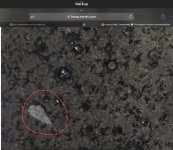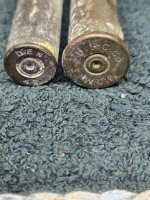It's a very dense stone and from 1-10 it's a 5 magnetic scale. It has little round balls inside and has a lot of shinny little specs all through it inside and out. When wet on cutt side, it's so shinny you can see reflection. It has passed streak test, all advise would be great. Thanks




You are using an out of date browser. It may not display this or other websites correctly.
You should upgrade or use an alternative browser.
You should upgrade or use an alternative browser.
I have no idea
- Thread starter Chr038
- Start date
- Jan 30, 2013
- 581
- 1,204
- Detector(s) used
- Whites
- Primary Interest:
- All Treasure Hunting
That one need might be a meteorite.
- Thread starter
- #3
Hello everyone. I have been running in circles with this possible meteorite and here are the test results. It says no but every geologist or meteoricist online says there's a flaw in the report, and to take it in. I've been trying to get someone to look at it here in Boise id but can't seem to find anyone not too busy. I really don't know how to read elements but have been trying. It's said flaw is on first page, well I have no idea what I'm looking at. Any insight would be great. Thanks


I don't know how to read it, and I wouldn't know a meteorite from a piece of porous tumbled river rock, but my sister is a geologist in Colorado and says XRF is spot on 99.9% of the time.
giuhalftrack
Jr. Member
- Jul 13, 2017
- 64
- 64
- Detector(s) used
- BFO's (DIY), Tesoro Silver, Tesoro Outlaw
- Primary Interest:
- All Treasure Hunting
ok just some hint.
this type of analysis are made like this:
you have the % in weight of elements... but this doesn't tell more about the "rock" because those elements can combined to form various minerals.. let's make an example.
suppose you have Fe, S, O
we can make an oxide Fe2O3
we can make a sulphide FeS
there is a calculation in which from an analysis like this you "rebuild" the minerals (It is a typical test to be a geologist in university I made it over 20 years ago : ) ). Obviously it is more convenient look at the rock and identify mineral, this is done for identification or classification.
The analysis report PPM (part per million 1/1,000,000) so we can say that those elements are not relevant.. (at least in this case....). What determine the nature of your sample are the other one (expressed in %).
If it was me (to see the cut rock I will trow away). the report say it is a gabbro so we have to say that...
If this rock was a meteorite it is a piece of a planet in which there was a magmatic activity similar to earth !! to produce same rocks.
but why there is no crust those rocks will melt at 1200° circa... a meteor undergo at over 2000° we expect a fusion ring around the cut rock...
those rocks will melt at 1200° circa... a meteor undergo at over 2000° we expect a fusion ring around the cut rock...
What kind of rocks are in the sample location ?
this type of analysis are made like this:
you have the % in weight of elements... but this doesn't tell more about the "rock" because those elements can combined to form various minerals.. let's make an example.
suppose you have Fe, S, O
we can make an oxide Fe2O3
we can make a sulphide FeS
there is a calculation in which from an analysis like this you "rebuild" the minerals (It is a typical test to be a geologist in university I made it over 20 years ago : ) ). Obviously it is more convenient look at the rock and identify mineral, this is done for identification or classification.
The analysis report PPM (part per million 1/1,000,000) so we can say that those elements are not relevant.. (at least in this case....). What determine the nature of your sample are the other one (expressed in %).
If it was me (to see the cut rock I will trow away). the report say it is a gabbro so we have to say that...
If this rock was a meteorite it is a piece of a planet in which there was a magmatic activity similar to earth !! to produce same rocks.
but why there is no crust
 those rocks will melt at 1200° circa... a meteor undergo at over 2000° we expect a fusion ring around the cut rock...
those rocks will melt at 1200° circa... a meteor undergo at over 2000° we expect a fusion ring around the cut rock...What kind of rocks are in the sample location ?
Red-Coat
Gold Member
Hi @Chr038
I declined to comment on your initial post simply because sometimes there’s not much that can be helpfully said from the information and pictures provided… except that, in this case, there are some characteristics that could be attributed to a meteorite and some “little round balls” that have at least the superficial appearance of chondrules.
Now that you have provided the additional analytical information, I can perhaps comment a little more helpfully.
You say that “every geologist or meteoricist online says there's a flaw in the report” (on the first page). Who exactly were these commenters (with what degree of experience in meteoritics) and surely they would have said what they believe the “flaw” to be?
I would say the following. The first page of the report (the second of your pictures) has a section titled “Key Diagnostic Indicators” and reports a Fe value of 6.786% with a Mn value of 0.091%. I’m guessing that’s what is being flagged as the “flaw” in the report.
Fe/Mn ratios are often touted as a key diagnostic for meteorites and, in this case, 6.768/0.091 gives a ratio of 74. That’s low for a chondritic meteorite (one would normally expect it to be >100). However, although the ratio doesn’t vary much within different groups of meteorites and some achondrite types have low values (euchrites are habitually lower than 50 for example), it’s not as “diagnostic” as some reference sources would suggest. There are some chondrite types which are lower than 100 and could conceivably be as low as 74, but those would be far less usual versus the possibilities for terrestrial materials (and also many Earth rocks have values in the range of meteoritic possibilities).
In defence of the analytical conclusions in the report I would say that although the Fe/Mn ratio on its own is not a key diagnostic, it becomes so if considered in conjunction with the other results and observations. So, not so much a “flaw” in the report, but more a general observation that hasn’t been portrayed in its proper context. That is, a chondrite couldn’t have a value that low while also having the other reported compositional values.
There are multiple clues in the report which, collectively, rule out this being a meteorite. For example, the silicon content is reported as 21.01%, so this would have to be a stony meteorite (If it were a meteorite). One of the best analytical parameters for distinguishing stony meteorites from Earth rocks is chromium content, since such meteorites almost invariably have high concentrations of chromium versus terrestrial rocks. The reported value is 376 ppm, whereas I would expect a value in excess of 1,000 ppm for a meteorite.
The report also says “optical analysis shows quartz”. That’s very much a “diagnostic” but it’s a contra-indicator for meteorites. Quartz is not found in meteorites with the exception of a few rare carbonaceous chondrites, which this specimen could not be. Even in those carbonaceous chondrites, the quartz crystals are microscopic in size and extremely low in abundance.
I don’t see any reason to doubt the laboratory’s conclusion that this is terrestrial material. Hope that helps.
I declined to comment on your initial post simply because sometimes there’s not much that can be helpfully said from the information and pictures provided… except that, in this case, there are some characteristics that could be attributed to a meteorite and some “little round balls” that have at least the superficial appearance of chondrules.
Now that you have provided the additional analytical information, I can perhaps comment a little more helpfully.
You say that “every geologist or meteoricist online says there's a flaw in the report” (on the first page). Who exactly were these commenters (with what degree of experience in meteoritics) and surely they would have said what they believe the “flaw” to be?
I would say the following. The first page of the report (the second of your pictures) has a section titled “Key Diagnostic Indicators” and reports a Fe value of 6.786% with a Mn value of 0.091%. I’m guessing that’s what is being flagged as the “flaw” in the report.
Fe/Mn ratios are often touted as a key diagnostic for meteorites and, in this case, 6.768/0.091 gives a ratio of 74. That’s low for a chondritic meteorite (one would normally expect it to be >100). However, although the ratio doesn’t vary much within different groups of meteorites and some achondrite types have low values (euchrites are habitually lower than 50 for example), it’s not as “diagnostic” as some reference sources would suggest. There are some chondrite types which are lower than 100 and could conceivably be as low as 74, but those would be far less usual versus the possibilities for terrestrial materials (and also many Earth rocks have values in the range of meteoritic possibilities).
In defence of the analytical conclusions in the report I would say that although the Fe/Mn ratio on its own is not a key diagnostic, it becomes so if considered in conjunction with the other results and observations. So, not so much a “flaw” in the report, but more a general observation that hasn’t been portrayed in its proper context. That is, a chondrite couldn’t have a value that low while also having the other reported compositional values.
There are multiple clues in the report which, collectively, rule out this being a meteorite. For example, the silicon content is reported as 21.01%, so this would have to be a stony meteorite (If it were a meteorite). One of the best analytical parameters for distinguishing stony meteorites from Earth rocks is chromium content, since such meteorites almost invariably have high concentrations of chromium versus terrestrial rocks. The reported value is 376 ppm, whereas I would expect a value in excess of 1,000 ppm for a meteorite.
The report also says “optical analysis shows quartz”. That’s very much a “diagnostic” but it’s a contra-indicator for meteorites. Quartz is not found in meteorites with the exception of a few rare carbonaceous chondrites, which this specimen could not be. Even in those carbonaceous chondrites, the quartz crystals are microscopic in size and extremely low in abundance.
I don’t see any reason to doubt the laboratory’s conclusion that this is terrestrial material. Hope that helps.
Last edited:
Al D
Bronze Member
- Thread starter
- #8
I can't thank you enough for breaking this down, your information really help with understanding it and also the research I have gathered over time. To answer your question , I do not know about the kinds of rocks that are where the sample came from, it was a gift to me from boss at the age of 16, yes old and I'm 40, now. I dont recall her telling me where it came from , she thought it was a thunderegg and handed it over. It has sat that long under my tree with all my other rocks intell my daughter wanted to cut it a couple years ago. Thank you again for your time and knowledge.ok just some hint.
this type of analysis are made like this:
you have the % in weight of elements... but this doesn't tell more about the "rock" because those elements can combined to form various minerals.. let's make an example.
suppose you have Fe, S, O
we can make an oxide Fe2O3
we can make a sulphide FeS
there is a calculation in which from an analysis like this you "rebuild" the minerals (It is a typical test to be a geologist in university I made it over 20 years ago : ) ). Obviously it is more convenient look at the rock and identify mineral, this is done for identification or classification.
The analysis report PPM (part per million 1/1,000,000) so we can say that those elements are not relevant.. (at least in this case....). What determine the nature of your sample are the other one (expressed in %).
If it was me (to see the cut rock I will trow away). the report say it is a gabbro so we have to say that...
If this rock was a meteorite it is a piece of a planet in which there was a magmatic activity similar to earth !! to produce same rocks.
but why there is no crustthose rocks will melt at 1200° circa... a meteor undergo at over 2000° we expect a fusion ring around the cut rock...
What kind of rocks are in the sample location ?
- Thread starter
- #9
Thank you kindly for your insight. I did word my post wrong, did not mean every geologist or metoricist, I actually was only talking about 3 of the gentlemen. Names I can't recall but they were interested in the shinny partials on outside of stone to know if it were Nickle, and the outer line on the cutt edge of stone that its been seen before in chondrites. They all also said 74 was in the realm of stoney chondrite, the flaw they all mentioned was the no in the yes box. Typo maybe was answered. That I need to haul it in to be held. With me not knowing what is what I kept asking around. I apologize for my word usage. It has been awesome getting opinions and details, it really helps and I can't thank you enough.Hi @Chr038
I declined to comment on your initial post simply because sometimes there’s not much that can be helpfully said from the information and pictures provided… except that, in this case, there are some characteristics that could be attributed to a meteorite and some “little round balls” that have at least the superficial appearance of chondrules.
Now that you have provided the additional analytical information, I can perhaps comment a little more helpfully.
You say that “every geologist or meteoricist online says there's a flaw in the report” (on the first page). Who exactly were these commenters (with what degree of experience in meteoritics) and surely they would have said what they believe the “flaw” to be?
I would say the following. The first page of the report (the second of your pictures) has a section titled “Key Diagnostic Indicators” and reports a Fe value of 6.786% with a Mn value of 0.091%. I’m guessing that’s what is being flagged as the “flaw” in the report.
Fe/Mn ratios are often touted as a key diagnostic for meteorites and, in this case, 6.768/0.091 gives a ratio of 74. That’s low for a chondritic meteorite (one would normally expect it to be >100). However, although the ratio doesn’t vary much within different groups of meteorites and some achondrite types have low values (euchrites are habitually lower than 50 for example), it’s not as “diagnostic” as some reference sources would suggest. There are some chondrite types which are lower than 100 and could conceivably be as low as 74, but those would be far less usual versus the possibilities for terrestrial materials (and also many Earth rocks have values in the range of meteoritic possibilities).
In defence of the analytical conclusions in the report I would say that although the Fe/Mn ratio on its own is not a key diagnostic, it becomes so if considered in conjunction with the other results and observations. So, not so much a “flaw” in the report, but more a general observation that hasn’t been portrayed in its proper context. That is, a chondrite couldn’t have a value that low while also having the other reported compositional values.
There are multiple clues in the report which, collectively, rule out this being a meteorite. For example, the silicon content is reported as 21.01%, so this would have to be a stony meteorite (If it were a meteorite). One of the best analytical parameters for distinguishing stony meteorites from Earth rocks is chromium content, since such meteorites almost invariably have high concentrations of chromium versus terrestrial rocks. The reported value is 376 ppm, whereas I would expect a value in excess of 1,000 ppm for a meteorite.
The report also says “optical analysis shows quartz”. That’s very much a “diagnostic” but it’s a contra-indicator for meteorites. Quartz is not found in meteorites with the exception of a few rare carbonaceous chondrites, which this specimen could not be. Even in those carbonaceous chondrites, the quartz crystals are microscopic in size and extremely low in abundance.
I don’t see any reason to doubt the laboratory’s conclusion that this is terrestrial material. Hope that helps.
Users who are viewing this thread
Total: 2 (members: 0, guests: 2)






